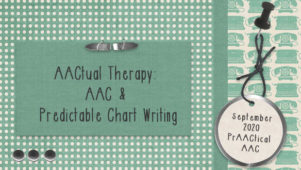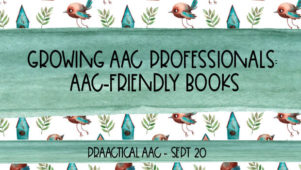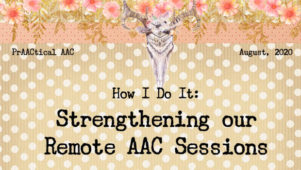Growing AAC Professionals: A Virtual AAC Camp
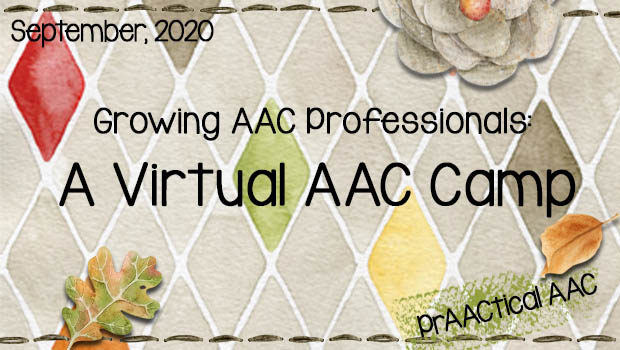
It’s no secret that there are not enough well-trained AAC professionals to meet the demands of children and adults with complex communication needs. Today, we’re pleased to highlight the work of Krista Davidson, a clinical educator who is addressing this chronic shortage by developing creative ways to support pre-professional students. As a clinical associate professor in the Department of Communication Sciences and Disorders at The University of Iowa, she created a virtual AAC camp as part of an inter-collegiate collaboration.
Let’s take a look.
Virtual AAC Camp – A Collaborative Effort in Preservice Training
Last year graduate students from The University of Iowa and the University of Northern Iowa (under the guidance Dr. Evette Edmister) worked in partnership with Easterseals Iowa to integrate an AAC camp into the summer program at Camp Sunnyside in Des Moines, IA. The intention was to continue that camp in the summer of 2020. But when life hands you a pandemic…go virtual! At least that appears to be the formula these days. After so much success with teletherapy, a virtual camp seemed possible. During our one-hour sessions, we decided to focus on a variety of literacy skills in the context of two superhero books over the span of three days. There was a dedicated website and a “camp-in-a-box” package sent to each camper. A good time was had by all!
However, this post is not about how to create a virtual camp, but rather to highlight the experience gained by the graduate student clinicians who participated. Whether in person or online, so many benefits come from the collaboration of students and professionals outside of one’s own program. After surveying the five graduate clinicians who served as camp counselors this summer, several themes emerged. First, many spoke to seeing therapy from a new point of view. The students each brought their own perspective to lesson plans and activities. They also discovered additional intervention strategies and ideas on how to integrate AAC in the telehealth universe. Secondly, our graduate clinicians valued real-world practice with interprofessional skills. They saw how they could work with the Easterseals Iowa staff in supporting the campers and caregivers’ knowledge of AAC and as a result, build up skills and breakdown barriers. Also, the nature of a statewide camp brought diversity to our group of campers. Students welcomed the exposure to more AAC systems as well as the opportunity to work with campers with different abilities in a group setting. Graduate clinicians are often limited to the caseloads at their own university clinic and may only see clients in one-on-one formats. Lastly, flexibility was interwoven into almost every response. From the ability to modify one plan to fit various needs to the ability to deviate from that plan and improvise, students reported these were the adaptive skills they would need in future clinical settings – virtual or otherwise.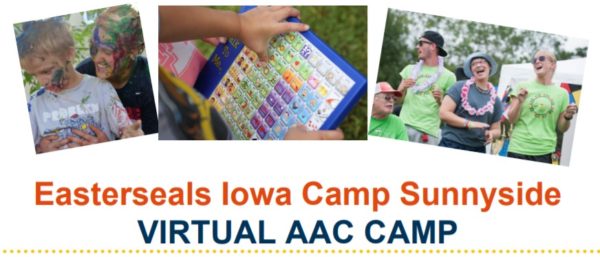
There was no defined road map for this endeavor, so Dr. Edmister and I had to forge our own path as we went. Although there were certainly elements we could streamline, remove, or improve, below are a few of the tools we employed to accomplish this initial collaboration. We used the usual suspects like encrypted Zoom meetings and group emails. However, the graduate students utilized the free GroupMe app (available on Apple and Android platforms) to communicate quickly with one another (without the watchful eyes of their pesky professors!). As mentioned above, Dr. Edmister set up a free Google Site for us to provide a camp overview, schedule, and resource website for families and caregivers. However, before the site went “live” it was a shared repository and staging area as we prepared for camp. Both professors and students could add and edit ideas and materials in one place for easy viewing. Additionally, we provided a detailed lesson plan format so the graduate student clinicians from both universities would have consistency when creating activities. Their plans had to include considerations for telepractice, specific goals and targets to accommodate a wide range of literacy skills and AAC experience, as well as directions for caregivers in order to support their camper during the session and for extra practice at home. An outline of that format and more about our preparation and debriefing process is included below.
Meeting schedule and feedback for students:
- Everyone was involved in the planning process to work collaboratively via reoccurring virtual planning sessions.
- Tasks for all involved, which included the students, were divided with established due dates.
- The students developed and posted draft lessons.
- The faculty reviewed and provided written and verbal (via video conference) feedback throughout the planning process to the students. Feedback was provided in both group and individual formats, depending on the feedback.
- Thirty minutes prior to each camp session, the team met (virtually) to review the plan, ensure all was ready, and test out all technology for the day. For example:
- testing screen sharing, split screens, spotlighting, or using extra cameras in front of devices for modeling the different AAC devices used by the campers.
- clarifying who was modeling when.
- After each session, in a group discussion, each team member highlighted what they felt went well, what might need to be adjusted for a future visit (i.e., cues/support, strategies, access, technology set up, activity directions, etc.) and/or what was
- Individual feedback was also given to each student by a faculty member.
It was decided the directions/lesson should:
- describe a literacy activity (with an emphasis on emergent literacy activities yet flexible enough for a possible wide range of literacy skills and AAC experience – to meet all needs),
- provide considerations for telepractice participation such as sharing the screen, using breakout rooms, annotation tools, etc. (Gregory, 2020).
- describe opportunities planned for communication interactions,
- include possible communication goals that can be individualized (planning for emergent, context-dependent, and independent AAC skill levels (Dowden, 2004) to prepare when skill levels may be varied or unknown) and align with the evidence-based literacy activity (Erickson & Koppenhaver, 2020),
- include strategies present to support AT needs (i.e., SMORRES (Senner & Baud, 2015) with specific detail such as – when modeling suggested describing exactly what is being modeled),
- describe vocabulary focus including vocabulary to regulate the activity,
- apply AT options/adaptations discussed in readings and meetings to provide access and engagement for the targeted literacy activities.
- include the directions the caregivers need to know in order to participate/support their camper during the session and ideas for extra practice at home.
In summary, the coordination and planning of such an undertaking may seem daunting, but, with our newfound familiarity with Zoom, it really is easier than ever to connect with universities and charitable organizations all over the country. As one student enthusiastically stated, “I think it is a good way to get involved in a larger community and interact with people outside of our field which is really more representative of the working world.” Therefore, I would encourage those involved in AAC preservice training to seek out ways to collaborate with students and professionals in other programs and different disciplines. Pandemic or not, we can carry these valuable skills forward for the betterment of our students and our clients.
You can download the lesson plan form that we developed here.
About the Guest Author
Krista Davidson is a clinical associate professor in the Department of Communication Sciences and Disorders at The University of Iowa. She can be reached at krista-davidson@uiowa.edu
Thank you to Dr. Evette Edmister, Abigail Denque, Megan Kinnerk, Jessica Parzynski, Shelby Rayhons, Jessica Spinelli, and Easterseals Iowa for your contributions to camp and this post.
::::::::::::::::::::::::::::::::::::::::::::::::::::::::::::::::::::::::::::::::::::::::::::
You can read Krista’s previous post here.
Filed under: Featured Posts, PrAACtical Thinking
Tagged With: preservice training, telepractice
This post was written by Carole Zangari


